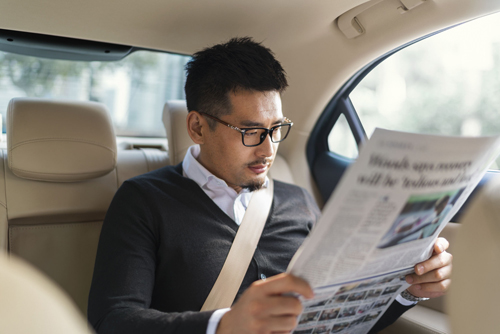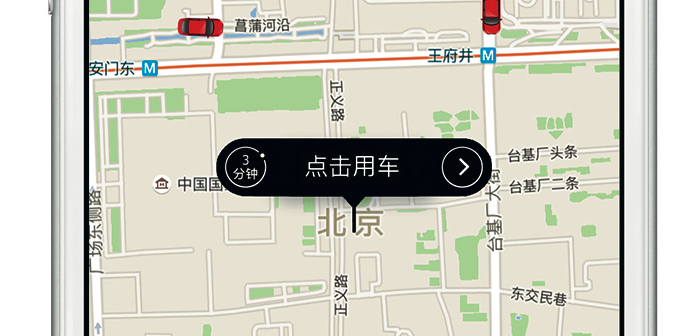(UPDATED) Transportation in Beijing via taxis is convenient and relatively cheap if you can get around the traffic. However, newcomers might shy from hailing taxis on their own due to the language barrier (the prospect of having to speak Mandarin), or a fear of being rejected by a cabbie (due to his fear of having to speak English). Fortunately, taxi and car hailing mobile apps have become more commonplace. In this guide, we outline the basics of taxis and the most foreigner-friendly private car hailing apps in Beijing.
Taxis
If your phone is out of battery, not set up for payment, or you just don’t want to try to speak Mandarin over the phone, a normal taxi will do just fine. Beijing taxi rates start at RMB 13 (RMB 14 between 11pm-5am), then RMB 2.30 per km (RMB 2.80 per km at night, RMB 3.5 after 15km). Most drivers do not speak English — you’re lucky if they speak standard Mandarin — and many are illiterate, in case you’re wondering why they get angry when you stick an address in their face. So sometimes it helps to prepare your own GPS using Baidu Maps, or at least a map with your intended location. It might be worth investing in a “taxi book”, which has lists of destinations with their addresses in Chinese characters and Pinyin. The newer versions have maps too, and there’s even an app for i-Phone, called Beijing Taxi-Book. Drivers tend to know major street names and landmarks such as tourist sites, but if you do encounter a clueless driver, try suggesting a nearby subway station to keep him on track. Be warned that taxis might smell of third hand smoke! They usually only take passengers from the right side (for safety reasons), and most do not have seat belts (so don’t bother with the child car seat). If you travel far, or use an expressway, the incurred toll fee will be added to your total cost (usually RMB 5-10) and you will receive the receipt for it. If you prefer ordering a taxi the traditional way (for a RMB 5 tip), then call 96103 and press 8 for English service.

Taxi Vocabulary
Prefer to just hail a cab? If possible, have the Chinese address handy. At first, it’s helpful to have a contact number for someone who can guide the driver if necessary. Here are some useful phrases:
• I’m going _____. Wǒ qù _____. 我去 _____。
• How much? Duō shao qián?多少钱?
• We’ve arrived. Dào le . 到了。
• Turn right. Zuǒ zhuǎn/guǎi. 右转/拐。
• Turn left. Yòu zhuǎn/guǎi. 左转/拐。
• Please give me the receipt. Qǐng gěi wǒ fāpiào. 请给我发票。
• Where are you going? Nǐ qù nǎr? 你去哪儿?
Dididache (Didi) 滴滴打车
Dididache, previously a taxi ordering service that merged with its American rival Uber in 2016, and has been providing us with everything we could possibly ask for in a car hailing service in one app. The app is not only available on iOS, Android, and Windows interfaces, but has also been added into the WeChat platform, allowing users to order a car even without downloading their app. The only caveat to the app is that it’s in Chinese.
How to use Didi on WeChat:
(note, you’ll need an active WeChat Wallet)
1. Click on the “Me” tab
2. Click on “Wallet” and you’ll see the option to “Order a Taxi” once you scroll down
3. Allow the app to find your location (click “OK”)
3. Fill in your locations (to and from)
4. Enter tip amount (optional)
5. The driver will call you to discuss the pick up
If you don’t want to pay via WeChat wallet, you can always pay cash and still get a receipt (fapiao), making it easy to order taxis for other people.
How to use the Didi app:
1. When you open the interface, select the type of service you want: Chūzūchē 出租车 (normal taxi), Kuàichē 快车 (private drivers), Zhuānchē 专车 (VIP version), Pīnchē 拼车 (carpool), or Dàijià 代驾 (driver drives your car for you)
2. Input pick up location by tapping into your GPS.
3. Input drop off location.
4. Wait for driver to call you.
5. Pay via app (unless it’s a legit taxi, in which case you could pay cash).
Payment method: Cash for licensed taxis, WeChat Wallet, and Alipay. Normally you have to go in and manually “pay” for the ride (and you won’t be able to request another ride until you’ve cleared your debts), but you can also set up “automatic payment” which will deduct as soon as the driver taps the arrive button. For company reimbursement purposes, if you do not pay cash or you use Didi private car services, you can request receipts to be sent to you for free if the fare is above RMB 200.
Verdict: Didi is the most convenient way to order a licensed taxi without having to add a tip. Since you’ve already inputted GPS locations and addresses, it also does not require much communication with the driver. The Kuàichē function is significantly cheaper, especially since Didi regularly gives users vouchers and coupons. While Kuàichē cars can be domestic, or even electric, Zhuānchē has higher standards where drivers are often professional chauffeurs working on the side. Pīnchē is the cheapest option of all as it is a legitimate carpool, but can be a slower alternative due to pitstops.
Photo: BFISHADOW and POELOQ (Flickr)
Editor’s note: This article had a section about Uber, but it was removed since the company had merged with Didi. This article originally appeared on pages 52 and 53 of the 2016 Home and Relocation Guide. Click here for your free online copy. To find out how you can obtain a hard copy, contact distribution@truerun.com.





4 Comments
Note that the article mixes up right and left towards the end of the article. It should be 右 (yòu) for right and 左 (zuǒ) for left.
Thank you for pointing that out, Andy! It’s now revised.
The receipt will show the method of payment?
Like saying specific that it’s paid with cash or it’s paid with app.
Thank you.
Not so sure which receipt you’re referring to here.